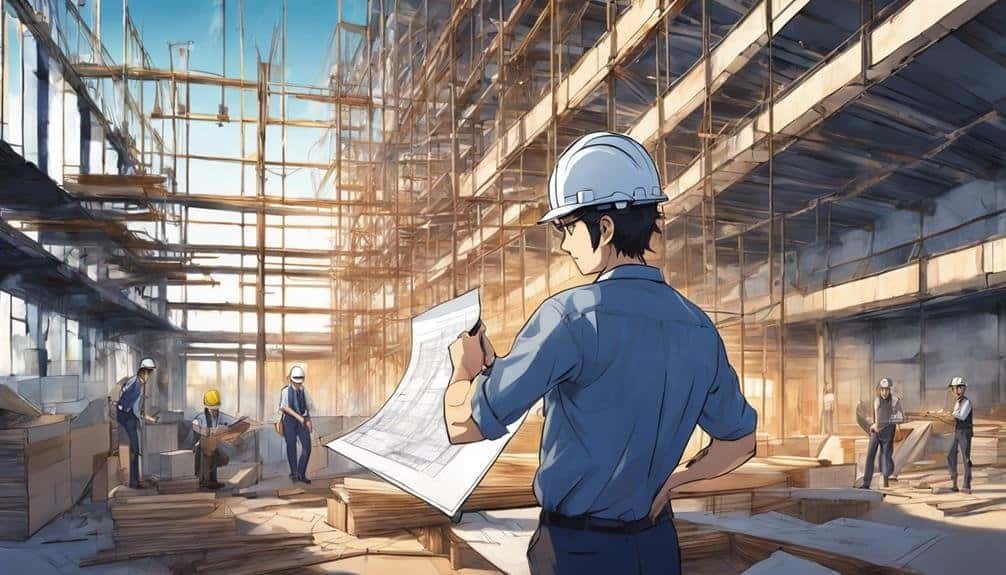Job Duties for Structural Engineer
Structural engineers play a vital role in the construction industry, utilizing their expertise to guarantee the safety and integrity of buildings and infrastructure. From analyzing complex structural systems to collaborating with various stakeholders, their job duties encompass a wide range of responsibilities that require precision and attention to detail.
However, there is one aspect of their work that often goes unnoticed but is essential for the successful completion of projects.
Key Takeaways
- Conduct rigorous structural analysis using advanced modeling techniques.
- Verify material quality to ensure structural integrity and safety.
- Coordinate project teams, schedules, and resources effectively.
- Ensure compliance with building codes, permits, and legal standards for stability.
Structural Analysis and Design
In the field of structural engineering, the core responsibility of professionals revolves around conducting rigorous structural analysis and design processes. This involves utilizing advanced structural modeling techniques to simulate the behavior of various materials under different conditions. One important aspect is seismic analysis, where engineers assess the structure’s ability to withstand earthquakes by considering factors like ground motion and building response.
Additionally, structural engineers are tasked with optimizing load distribution within a building to guarantee that all components bear weight efficiently. This requires a deep understanding of how forces act on different parts of a structure and how to mitigate potential weak points.
Foundation design is also a crucial component of structural analysis and design, as it sets the groundwork for the entire building’s stability. Engineers must calculate the type and depth of foundations needed based on soil conditions and the structure’s load-bearing requirements.
Material Selection and Testing
Material selection and testing are critical aspects of a structural engineer’s responsibilities. This involves the analysis of material strength and adherence to stringent quality control procedures. Engineers must meticulously evaluate the properties of various materials to ensure they meet the structural requirements of the project.
Quality control procedures are essential in guaranteeing the integrity and safety of the structure being designed.
Material Strength Analysis
Evaluating the strength characteristics of diverse materials through rigorous selection and testing procedures is a fundamental aspect of a structural engineer’s role in ensuring the structural integrity and safety of buildings and infrastructure. Material durability evaluation involves analyzing how different materials withstand various environmental conditions over time. Stress analysis is important for determining how materials respond to different loads and pressures, ensuring they can support the intended structures. Structural integrity assessment focuses on verifying that materials can maintain their form and function under different conditions. Load capacity estimation involves calculating the maximum load a material can bear before failure. These analyses guide engineers in selecting the most suitable materials for construction projects.
| Material Strength Analysis | ||||
|---|---|---|---|---|
| Material Durability Evaluation | Stress Analysis | Structural Integrity Assessment | Load Capacity Estimation | Material Selection |
| Analyzing long-term durability | Analyzing stress distribution | Verifying material properties | Calculating maximum load | Choosing suitable materials |
Quality Control Procedures
To guarantee the structural integrity and safety of buildings and infrastructure, structural engineers implement rigorous quality control procedures focused on material selection and testing. Inspection protocols are meticulously followed to assess the quality of materials used in construction.
Data analysis plays a vital role in identifying any deviations from standards, enabling engineers to take corrective actions promptly. Additionally, structural engineers work on process improvement initiatives to enhance material selection processes continually.
They may develop and implement training programs to make sure that all team members involved in material selection and testing are well-versed in the required protocols and standards. By adhering strictly to quality control measures, structural engineers uphold the highest standards of safety and reliability in construction projects.
Project Management and Coordination
Structural engineers play an important role in project management and coordination by facilitating team collaboration and ensuring schedule adherence.
Effective communication and coordination among team members are essential for the successful execution of structural projects.
Team Collaboration
Effective project management and coordination are essential aspects of team collaboration for structural engineers. Communication strategies and problem-solving techniques play an important role in ensuring effective team dynamics and conflict resolution strategies within a structural engineering project team. By implementing clear communication channels and fostering a problem-solving mindset, structural engineers can enhance collaboration among team members and streamline project processes. Conflict resolution strategies are also important to address any disagreements or issues that may arise during the project, ensuring that team productivity is maintained. The table below highlights key strategies for effective team collaboration in structural engineering projects:
| Communication Strategies | Problem-Solving Techniques |
|---|---|
| Clear and concise communication | Brainstorming solutions together |
| Regular team meetings for updates | Analyzing root causes of issues |
| Utilizing project management tools | Implementing decision matrices |
| Active listening among team members | Encouraging creativity in problem-solving |
| Setting clear expectations and goals | Seeking input from all team members |
Schedule Adherence
In the domain of project management and coordination for structural engineers, maintaining adherence to schedules is a vital component that directly impacts the overall success and efficiency of a project. Time management plays an essential role in ensuring that project timelines are met without delays.
Structural engineers must meticulously plan tasks, allocate resources efficiently, and set realistic deadlines to achieve project milestones. Deadline tracking is essential to monitor progress and identify potential bottlenecks that could disrupt the schedule.
Progress monitoring allows for adjustments to be made promptly, ensuring that the project stays on track. By employing effective schedule adherence practices, structural engineers can enhance project outcomes, meet client expectations, and optimize resource utilization.
Building Code Compliance
Ensuring adherence to relevant building codes is a fundamental responsibility for structural engineers in their design and analysis processes. Compliance with permit requirements and design constraints is essential to guarantee that the structural elements meet the legal standards set by local authorities.
Safety regulations play a significant role in dictating the materials, methods, and specifications that must be followed to guarantee the well-being of occupants and the public. Structural integrity is a key consideration for engineers, as they need to make sure that the building can withstand various loads and environmental conditions without compromising its stability.
Failure to comply with building codes can result in costly revisions, legal issues, and, most importantly, compromised safety. To summarize, building code compliance is a cornerstone of structural engineering practice, requiring meticulous attention to detail and a deep understanding of regulatory requirements.
Site Inspections and Assessments
Conducting thorough site inspections and evaluations is a critical aspect of a structural engineer’s role to guarantee the integrity and safety of construction projects. Structural engineers are responsible for evaluating the structural soundness of buildings and infrastructure. This involves inspecting the materials used, the foundation, beams, and overall design to ensure compliance with safety protocols and building codes. Utilizing a beam calculator can help accurately assess the load-bearing capacity of beams, ensuring they meet structural requirements and contribute to a safe construction.
Site inspections also entail evaluating the environmental impact of the construction project. Structural engineers must consider factors such as soil composition, drainage systems, and the surrounding ecosystem to minimize any adverse effects.
During site inspections, structural engineers utilize their technical expertise to identify potential risks and structural weaknesses. They evaluate whether the construction is progressing according to the approved plans and specifications, making adjustments as necessary to uphold structural integrity. Additionally, engineers must collaborate with other professionals on-site to address any issues that may compromise the safety or stability of the structure. By meticulously conducting site inspections and evaluations, structural engineers play a vital role in ensuring the safety and longevity of construction projects.
Collaboration With Architects and Contractors
Collaboration between structural engineers, architects, and contractors is fundamental to the successful execution of construction projects, ensuring seamless integration of design and structural requirements. This collaboration is essential for achieving structural integrity while honoring the architectural vision of the project.
Here are key aspects of collaboration in this tripartite relationship:
- Design Coordination: Structural engineers work closely with architects to make sure that the structural elements align with the overall design goals, balancing aesthetics with functionality.
- Construction Collaboration: Throughout the construction phase, ongoing communication between all parties is essential to address any unexpected challenges and make sure that the project stays on track.
- Structural Integrity: By working together, engineers, architects, and contractors can guarantee that the final structure meets all safety and stability standards without compromising the design intent.
- Architectural Vision: It is essential to preserve and enhance the architect’s vision while making sure that the structure is safe, durable, and compliant with regulations.
Risk Assessment and Mitigation
An important aspect of the structural engineering process involves evaluating and mitigating potential risks associated with the design and construction of a building. To achieve this, structural engineers utilize various risk assessment techniques to identify potential hazards that may compromise the structural integrity or safety of the building. These techniques involve thorough analyses of factors such as material strengths, environmental conditions, and structural loads to assess the likelihood of risks occurring.
Once risks are identified, structural engineers develop mitigation strategies to address and minimize these potential hazards. This may include implementing safety protocols during the construction phase, such as regular inspections, quality control measures, and adherence to building codes and regulations. Additionally, engineers work closely with architects, contractors, and other stakeholders to confirm that risk mitigation strategies are effectively integrated into the overall project plan.
Use of Structural Engineering Software
Incorporating advanced structural engineering software tools facilitates the efficient analysis and design of building structures, enhancing the precision and effectiveness of the engineering process. Structural engineers rely on these software tools for various tasks, including:
- Software Training: Continuous training on the latest structural engineering software is important for engineers to stay updated with new features and capabilities.
- Industry Standards: The software aids in adhering to industry standards and codes by providing design templates and analysis tools that guarantee compliance.
- Efficient Modeling: Utilizing software for 3D modeling and simulation allows engineers to visualize structural behavior accurately before construction.
- Cost Optimization: By running simulations and analyses on software, engineers can identify cost-effective design solutions that meet structural requirements.
Continuous Professional Development
Continuous professional development is essential for structural engineers to enhance their skills and stay abreast of industry advancements. Engaging in certification programs and seizing training opportunities are critical for maintaining competence and guaranteeing compliance with evolving standards in the field. Additionally, attending networking events and industry conferences provides avenues for knowledge exchange, exposure to new technologies, and collaboration with peers, hence fostering professional growth and keeping abreast of the latest trends.
| Aspect | Description | Importance |
|---|---|---|
| Certification Requirements | Fulfilling mandatory certification requirements ensures that structural engineers meet industry standards and regulations. | High |
| Training Opportunities | Participating in training programs enhances technical skills and knowledge, keeping professionals competitive in the industry. | High |
| Networking Events | Attending networking events facilitates connections with industry experts, potential clients, and collaborators. | Medium |
| Industry Conferences | Participating in industry conferences offers insights into cutting-edge technologies and trends, fostering professional development. | Medium |
| Continuous Learning | Embracing a culture of continuous learning is essential for structural engineers to adapt to changes and advancements in the field. | High |
Conclusion
To summarize, the job duties of a structural engineer involve a wide range of responsibilities including:
- Structural analysis
- Material selection
- Project management
- Code compliance
- Site inspections
- Collaboration with architects and contractors
- Risk assessment
- Continuous professional development
By fulfilling these duties diligently, structural engineers contribute to the safety, efficiency, and success of construction projects.
Their expertise and attention to detail are essential in ensuring the structural integrity of buildings and infrastructure.







